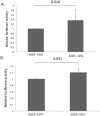AGER -429T/C is associated with an increased lung disease severity in cystic fibrosis
- PMID: 22860029
- PMCID: PMC3408394
- DOI: 10.1371/journal.pone.0041913
AGER -429T/C is associated with an increased lung disease severity in cystic fibrosis
Abstract
The clinical course of cystic fibrosis (CF) varies between patients bearing identical CFTR mutations, suggesting the involvement of modifier genes. We assessed the association of lung disease severity with the variant AGER -429 T/C, coding for RAGE, a pro-inflammatory protein, in CF patients from the French CF Gene Modifier Study. We analyzed the lung function of 967 CF patients p.Phe508del homozygous. FEV(1) was analyzed as CF-specific percentile adjusted on age, height and mortality. AGER -429T/C polymorphism was genotyped and its function was evaluated in vitro by measurement of the luciferase activity. AGER -429 minor allele (C) was associated with poorer lung function (p = 0.03). In vitro, the promoter activity was higher in cells transfected with AGER -429C compared to cells transfected with the AGER -429T allele (p = 0.016 in BEAS-2B cells). AGER seems to be a modifier gene of lung disease severity in CF, and could be an interesting biomarker of CF airway inflammation. The functional promoter AGER -429C variant is associated with an increased RAGE expression that can lead to an increased lung inflammation and a more severe lung disease.
Conflict of interest statement
Figures


References
-
- Corvol H, Fitting C, Chadelat K, Jacquot J, Tabary O, et al. (2003) Distinct cytokine production by lung and blood neutrophils from children with cystic fibrosis. Am J Physiol Lung Cell Mol Physiol 284: L997–1003. - PubMed
-
- Mukherjee TK, Mukhopadhyay S, Hoidal JR (2008) Implication of receptor for advanced glycation end product (RAGE) in pulmonary health and pathophysiology. Respir Physiol Neurobiol 162: 210–5. - PubMed
Publication types
MeSH terms
Substances
LinkOut - more resources
Full Text Sources
Medical

